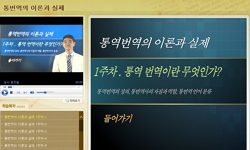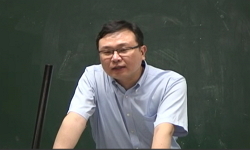This paper investigates the korean translation 『고요한 돈』(The Quiet Don), which was translated by Baek Seuk from The Quiet Don by Mikhail Sholokhov (1905-1984). The translated book has earned a lot of praise due to its natural expression of K...
http://chineseinput.net/에서 pinyin(병음)방식으로 중국어를 변환할 수 있습니다.
변환된 중국어를 복사하여 사용하시면 됩니다.
- 中文 을 입력하시려면 zhongwen을 입력하시고 space를누르시면됩니다.
- 北京 을 입력하시려면 beijing을 입력하시고 space를 누르시면 됩니다.

백석의 『고요한 돈』 번역 연구 = A Study on Baek Seok`s Korean Translation of The Quiet Don of M. Sholokhov
한글로보기https://www.riss.kr/link?id=A101148609
- 저자
- 발행기관
- 학술지명
- 권호사항
-
발행연도
2015
-
작성언어
-
-
주제어
백석 ; 숄로호프 ; 『고요한 돈』 ; 번역 ; 의성어 ; Baek Seok ; Sholokhov ; The Quiet Don ; Translation ; Onomatopoeia
-
KDC
700
-
등재정보
KCI등재
-
자료형태
학술저널
-
수록면
91-128(38쪽)
-
KCI 피인용횟수
3
- DOI식별코드
- 제공처
-
0
상세조회 -
0
다운로드
부가정보
다국어 초록 (Multilingual Abstract)
This paper investigates the korean translation 『고요한 돈』(The Quiet Don), which was translated by Baek Seuk from The Quiet Don by Mikhail Sholokhov (1905-1984). The translated book has earned a lot of praise due to its natural expression of Korean. Yet a lot of studies which have been conducted in Korea may have their limitations because they have been done based on only the translated book. Now this paper analyzes the merit and demerit of Baek Seuk``s translation by contrasting the translated book with the original one in terms of translation. To analyze its style, this study was conducted based on studies of Herman Ermolaev and F. G. Biryukov. The other papers in Korea were also examined critically. First, the dialects and varieties of indigenous expressions used by Baek Seuk show the artistic accomplishment of the original work very well, even though some dialects and indigenous expressions of the former do not coincide in those of the original work in terms of style. In fact, analyzing Baek Seuk``s translated book reveals that translation of adjective ``lazorevyi`` of Russian does not correctly represent the poetic image of the original work. Second, Baek Seuk``s translation of epithets used by Sholokhov was analyzed in this study. The results show that the natural expression of Korean chosen by Baek Seuk is made enough to well convey the impression of epithets of the original work. Especially his ability to translate color adjectives in the original one turns to be admirable; He provides an exemplary answer of how to translate one color by using a variety of Korean expressions. But his korean translations of the compounds of color adjectives of Sholokhov in The Quiet Don only explain the meaning of them. Finally, the onomatopoeia and mimesis used to translate verbs of the original book were also compared and analyzed with some limitations. It can be said that Baek Seuk successfully conveys the mood of the words by making a careful selection of Korean counterparts to the Russian onomatopoetic words written in the original work. Here, even though a lot of cases to translate Russian verbs into forms of adverbs and verbs, were observed, they remain unexamined and are taken to a next theme because of more careful analysis.
참고문헌 (Reference)
1 최유찬, "「고요한 돈」의 한국어 번역 판본 비교 - 백석 번역본을 중심으로 -" 한국학연구소 (43) : 37-96, 2012
2 채완, "한국어의 의성어와 의태어" 서울대학교출판부 2003
3 이기원, "한국어의 의성어와 의태어" 한국문화사 2007
4 임흥수, "한국어, 러시아어, 영어 어순의 유형론 - 부사의 위치와 관련된 어순을 중심으로 -" 아시아중동부유럽학회 11 (11): 33-58, 2009
5 신중진, "한국어 의성어와 의태어에 대한 재론 -채완(2003)을 중심으로-" 형태론 10 (10): 437-454, 2008
6 국립국어연구원, "표준국어대사전"
7 김이협, "평북방언사전" 한국정신문화연구원 1981
8 체호프, "체호브 선집" 조쏘출판사 1955
9 체호프, "지구적 세계문학(제4호)" 글누림출판사 2014
10 배대화, "지구적 세계문학" 글누림출판사 2015
1 최유찬, "「고요한 돈」의 한국어 번역 판본 비교 - 백석 번역본을 중심으로 -" 한국학연구소 (43) : 37-96, 2012
2 채완, "한국어의 의성어와 의태어" 서울대학교출판부 2003
3 이기원, "한국어의 의성어와 의태어" 한국문화사 2007
4 임흥수, "한국어, 러시아어, 영어 어순의 유형론 - 부사의 위치와 관련된 어순을 중심으로 -" 아시아중동부유럽학회 11 (11): 33-58, 2009
5 신중진, "한국어 의성어와 의태어에 대한 재론 -채완(2003)을 중심으로-" 형태론 10 (10): 437-454, 2008
6 국립국어연구원, "표준국어대사전"
7 김이협, "평북방언사전" 한국정신문화연구원 1981
8 체호프, "체호브 선집" 조쏘출판사 1955
9 체호프, "지구적 세계문학(제4호)" 글누림출판사 2014
10 배대화, "지구적 세계문학" 글누림출판사 2015
11 미하일 숄로호프, "전집 전8권" 프라브다출판사 1975
12 체호프, "전집 31권" 과학아카데미출판사 1985
13 채완, "의성어·의태어의 통사와 의미" 국립국어연구원 3 (3): 1993
14 윤희원, "의성어·의태어의 개념과 정의" 국립국어연구원 3 (3): 1993
15 최유찬, "예술번역’으로 읽는 혁명과 사랑의 교향악 – 백석 번역 고요한돈 의 문학적 특질" 22 (22): 2012
16 발터 벤야민, "언어 일반과 인간의 언어에 대하여 / 번역자의 과제 외" 도서출판 길 2010
17 임홍빈, "어순에 관한 언어 유형적 접근과 한국어의 기본 어순" 22 : 2007
18 백석, "백석전집" 실천문학사 2011
19 배대화, "백석의 푸시킨 번역시 연구" 한국외국어대학교 러시아연구소 28 (28): 1988
20 방민호, "백석의 숄로호프 번역 전후" 2012
21 이상숙, "백석의 번역 작품 「자랑」, 「숨박꼭질」 연구 - 북한 문학 속의 백석 Ⅳ -" 한국근대문학회 (27) : 99-154, 2013
22 배대화, "백석의 러시아 문학 번역에 관한 소고 - 남ㆍ북한의 평가를 중심으로" 인문과학연구소 31 : 35-56, 2013
23 황선희, "백석 시의 문체적 특성 연구 – 분단 이전 시편들과 분단 이후의시·번역시의 연속성 문제를 중심으로" 중앙대학교 2015
24 이상숙, "백석 번역시 연구를 위한 시론(試論): 북한 문학 속의 백석 Ⅲ" 한국비평문학회 (46) : 33-64, 2012
25 신서인, "문장부사의 위치에 대한 고찰" 국어학회 (61) : 207-238, 2011
26 김정우, "모파상 단편 ‘L’odysse d’une fille’의 한국어 번역과 영어 번역의 비교 연구" 한국번역학회 11 (11): 64-91, 2010
27 "로조사전" 러씨야말 출판사 1988
28 김태진, "러시아어 의성어 연구" 한국노어노문학회 21 (21): 17-47, 2009
29 방민호, "고요한돈 1, 2" 서정시학 2013
30 숄로호프, "고요한 돈, (1), (2)" 문예출판사 1989
31 미하일 숄로호프, "고요한 돈 전4권" 예술문학출판사 1957
32 미하일 숄로호프, "고요한 돈 1, 2권" 서정시학 2013
33 ショーロホフ., "静かなドン, I, II" 河出書房 1957
34 Бирюков, Ф.Г., "Шолохов, Издательство Московского университета" Moscow University Pr 1998
35 Даль, Владимир., "Толковый словарь живого великорусского языка, том 1, 2.3. 4" Русский язык 1980
36 Ушаков, Д.Н., "Толковый словарь Ушакова. 1935-1940"
37 Кузнецов, Феликс., "Судьба и правда великкого романа. Москва" ИМЛИ РАН
38 Тихонов, А.Н., "Словообразовательный словарь русского языка, том 1, 2" Русский язык 1985
39 "Словарь русских народных говоров, издательство" Наука 1965
40 "Словарь русских народных говоров, Составил Ф. П. Филин, издательство “Наука”, М., Л., 1965~2010"
41 Бен-Лев, Сергей., "Словарь звукоподражательных глаголов"
42 "Казачий словарь-справочник"
43 Олма Медиа Групп., "Большой словарь русских поговорок"
44 Herman Ermolaev., "Sholokhov And his Art" Princeton Univ., Pr 1982
45 추석훈, "Korean Comics in Russia – Notes on Onomatopoeia and Mimesis" 동유럽발칸연구소 35 : 31-51, 2013
동일학술지(권/호) 다른 논문
-
러시아어의 슬픔 의미 연구: 감정 언어의 인지의미론적 고찰
- 한국외국어대학교 러시아연구소
- 안혁 ( Hyug Ahn )
- 2015
- KCI등재
-
유라시아경제연합의 화폐통합 가능성 평가와 과제: 유럽 화폐통합 사례의 함의
- 한국외국어대학교 러시아연구소
- 변현섭 ( Hyun Sub Byun )
- 2015
- KCI등재
-
기록보존소 자료를 통해 본 소비에트 시기 최초의 한인 해군장교 (최 파벨 페트로비치)의 죽음과 스탈린 탄압의 비극
- 한국외국어대학교 러시아연구소
- 이병조 ( Byong Jo Lee )
- 2015
- KCI등재
-
- 한국외국어대학교 러시아연구소
- 홍완석 ( Wan Suk Hong )
- 2015
- KCI등재
분석정보
인용정보 인용지수 설명보기
학술지 이력
| 연월일 | 이력구분 | 이력상세 | 등재구분 |
|---|---|---|---|
| 2027 | 평가예정 | 재인증평가 신청대상 (재인증) | |
| 2021-01-01 | 평가 | 등재학술지 유지 (재인증) |  |
| 2018-01-01 | 평가 | 등재학술지 유지 (등재유지) |  |
| 2015-01-01 | 평가 | 등재학술지 유지 (등재유지) |  |
| 2011-01-01 | 평가 | 등재학술지 유지 (등재유지) |  |
| 2009-09-02 | 학술지명변경 | 외국어명 : The Korean Journal of Slavic Studies -> The Korean Journal of Slavic Studies |  |
| 2009-09-01 | 학술지명변경 | 외국어명 : 미등록 -> The Korean Journal of Slavic Studies |  |
| 2009-01-01 | 평가 | 등재학술지 유지 (등재유지) |  |
| 2007-01-01 | 평가 | 등재학술지 유지 (등재유지) |  |
| 2006-01-17 | 학술지명변경 | 한글명 : 슬라브연구 -> 슬라브硏究 |  |
| 2004-01-01 | 평가 | 등재학술지 선정 (등재후보2차) |  |
| 2003-01-01 | 평가 | 등재후보 1차 PASS (등재후보1차) |  |
| 2001-07-01 | 평가 | 등재후보학술지 선정 (신규평가) |  |
학술지 인용정보
| 기준연도 | WOS-KCI 통합IF(2년) | KCIF(2년) | KCIF(3년) |
|---|---|---|---|
| 2016 | 0.58 | 0.58 | 0.52 |
| KCIF(4년) | KCIF(5년) | 중심성지수(3년) | 즉시성지수 |
| 0.44 | 0.41 | 0.844 | 0.33 |




 KCI
KCI KISS
KISS






